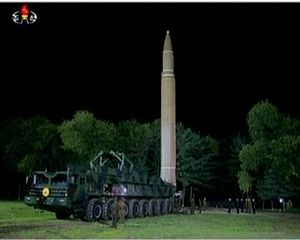The U.S. Central Intelligence Agency (CIA) has assessed that North Korea’s Hwasong-14/KN20 intercontinental-range ballistic missile (ICBM) test launch on July 28 failed to demonstrate successful atmospheric reentry, The Diplomat has learned. The same assessment, however, notes that North Korea’s ICBM reentry vehicles would likely perform adequately if flown on a normal trajectory to continental U.S. targets.
U.S. government sources with knowledge of the confidential CIA assessment released in early August note that the reentry vehicle of the Hwasong-14 ICBM launched out of Mupyong-ni on July 28 did not survive to splashdown in the Sea of Japan. The reentry vehicle likely disintegrated; the assessment cites the high lofted trajectory of the July 28 launch as the primary reason for the reentry vehicle’s failure.
The CIA assessment notes that based on the two observed flight tests of the Hwasong-14 to date, North Korea’s reentry vehicle technology is likely sufficiently advanced to pose no performance problem should the missile be fired at a minimum energy trajectory. The assessment of the reentry vehicle is supported by analysis of data “gathered from ground, sea, and air-based sensors” by the U.S. National Air and Space Intelligence Center (NASIC), one source told The Diplomat.
A ballistic missile’s reentry vehicle contains its explosive payload and must withstand immense structural and temperature pressures during its descent through the earth’s atmosphere to its intended target. These physical stresses are exceptionally severe in the case of ICBMs, which fly higher than shorter-range systems and reach speeds several multiples of the speed of sound during descent.
According to a U.S. government source with knowledge of the latest ICBM test, the North Korean ICBM’s reentry vehicle on July 28 would have encountered structural stresses in excess of those it would see during a minimum energy trajectory flight toward continental U.S. targets.
The CIA assesses this to be primarily due to the exceptionally high apogee of 3,700 kilometers it reached during the flight; North Korea did this seeking to demonstrate the missile’s full range capabilities within the Sea of Japan. Temperature stresses on the RV, meanwhile, would likely last longer during reentry off a minimum energy trajectory flight than they would have during the July 28 flight.
North Korea’s own state media statement on the July 28 test did not make any claim that the reentry vehicle survived following the July 28 test. The Korean Central News Agency statement released after the test did note that the “accurate guidance and attitude control of warhead was ensured at the atmospheric reentry at the angle launch system harsher (sic) than the actual maximum range flying conditions” (emphasis added).
After the July 4 test, however, North Korea noted that “the warhead accurately hit the targeted waters without any structural breakdown at the end of its flight” — an exaggerated claim, according to U.S. intelligence assessments.
As The Diplomat has previously reported, the July 4 Hwasong-14 ICBM test saw the reentry vehicle survive to approximately an altitude of 1 kilometer. Despite this, a 30 kiloton nuclear payload — a common estimate for the boosted fission device North Korea is thought to have tested in September 2016 — could be successfully delivered at that altitude using an airburst.
Despite the CIA assessment that North Korea’s reentry vehicle technology would perform adequately on a minimum energy trajectory, Pyongyang has yet to prove this given that it continues to avoid overflying Japan and carry out tests of its long-range missiles on lofted trajectories within the Sea of Japan.
However, as a statement released this week suggests, North Korea may soon look to conduct full-range flight tests of its ICBM and Hwasong-12 intermediate-range ballistic missile into the Pacific Ocean. These tests would allow it to prove its reentry vehicle performance under conditions more similar to the kinds of flights these missiles would be required to undertake in operational scenarios to attack the U.S. homeland.
Accordingly, the CIA’s assessment also anticipated a future Hwasong-14 launch to prove the reentry vehicle’s performance at full range.






























